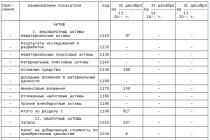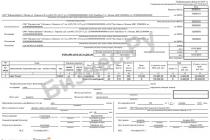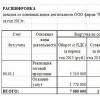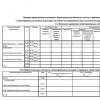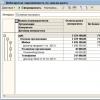The reporting period code for declarations is indicated when the title page is filled in the document. The code is needed to indicate the time for which the income tax itself is surrendered. In this article, we will consider in detail the features of filling out tax returns and codes for tax periods.
General information about codes by reporting period
The code itself can be made up of different combinations with numbers. For example, 24, 34, 31, 01 and so on. This notation makes it possible to encrypt tax period information, which is established for each type of fee, by the government itself and by law. Usually, the calendar year is taken as the tax period. But you can use other periods of time, after which it is necessary to make calculations, transfer funds.
VAT declaration: what designations should be put?
If an organization has an obligation to pay this tax, then it indicates the following figures in its documents:
When filling out, it is recommended to rely on the procedure established by the Order of the Federal Tax Service No. [email protected] The order was issued in 2014. There are separate types of data that must be entered in the field associated with the designation of the tax period. The code always has the first digit, which will be a two. The second is changed depending on which quarter the payment is made for.
A similar system can be applied to the reporting of any tax that requires quarterly payment. For example, this applies to, or water tax.
Drawing up profitable reports
If a figure such as 21 is used, it means that it is paid based on the results of the first quarter of activity. If the declaration is semi-annual, then the number 31 is allowed. As for the digital code 31, it indicates that documents are submitted for nine months, from January 1 to September 30. 34 is a suitable figure for the declaration of income for the year.

But not all entrepreneurs who draw up declarations use the designations mentioned above. If advance payments are introduced for this tax, a different coding is applied - 01, 02, 03, and so on.
Rules for filling in the field 107
Codes for reporting periods are affixed not only in the declarations themselves. They are necessary for payment orders, which are issued when transferring to the budget. It is for numbers by periods that the 107th field is intended.
In these documents, the code already consists of ten characters, in contrast to the usual two-digit options in declarations. The composition can be deciphered as follows:
- There are the first two signs that indicate the frequency of receipt. MS for the month, KV for the quarter, and so on.
- The next two digits hide the number of the month, quarter or half year.
- The year for which the tax is paid is hidden behind 7-10 characters.
Determination of the correct tax period for profit
The standard tax period, as mentioned, is one year. It usually runs from January 1st to December 31st. But this is a general case, from which there are always exceptions. Among them, the most common case is the organization, or the liquidation or creation of a company from the middle of the year.
A separate period of time is determined for organizations that were newly created.
- If registration took place in December, the reporting is within the day of creation - the end of the next calendar year.
- Or from the date of creation until the end of the current calendar year.
Another will be the segment for a company that is being liquidated or organized.
- Or from the beginning of the year until the moment the reorganization is completed.
- Or from the date of creation to liquidation or reorganization.
Declarations and their completion
Any tax return- this is a written statement about how much money the compiler received, how much he spent. In addition, the document contains information related to sources of income, benefits if necessary, tax amounts calculated, and so on.

Each taxpayer draws up a separate document for each type of tax. Unless otherwise provided by law.
The document is submitted to the tax office at the place where the applicant is registered. Only established forms are used to fill in, the information carrier can be paper or electronic. The tax authorities provide forms free of charge, where the necessary information is entered. The day of submission of the tax return is the date when the letter was sent along with the list of attachments. Sending is considered the moment of transmission if telecommunication channels are used.
The tax return must be sent, indicating a single identification number belonging to the originator himself. The specified procedure for submitting documents is also correct if the contributions paid to state non-budgetary funds are determined. Forms and filling procedures are developed separately by each of these institutions.
For the past tax period, the declaration must be submitted:
- If this is an individual entrepreneur - no later than April 30 in the year following the tax period that has already expired.
- Organizations - up to a maximum of March 31 in the year following the reporting period.
On determining tax rates
Tax rates are established by the relevant sections of the current legislation.
- 15 percent - when used as taxation of income reduced by the amount of expenses.
- 6 percent if the taxpayer works only with income.
The size of the tax rate is one of the main elements that is taken into account not only when switching to a particular taxation system, but also when choosing objects for which funds are transferred. There are other factors to take into account:
- The need to reduce the number of employees in the accounting department.
- Probability of violation of the conditions provided for in Article 346.12 of the Tax Code of the Russian Federation.
Paying only the income of the organization is beneficial for those who have a product profitability of less than 40 percent. If this indicator is greater, then it is better to make the object of income reduced by the amount of expenses.
What information is hidden in declarations as a code?
Encoding for the declaration is usually subject to the following information:
- Data on who signs: the payer himself, or an authorized representative on the basis of a document on the transfer of authority.
- Information on liquidation or reorganization.
- Belonging to a specific tax office. In this case, everything also depends on whether the enterprise is a large payer or not.
- The name of the inspection itself, where the document is sent.
When working with
If the enterprise is being liquidated, its owner must submit an application using the UTII-4 form. If an individual entrepreneur closes his business, he must also submit a declaration to the regulatory authority. And pay the tax to the treasury in the usual time, even if at that moment he already loses the status of an entrepreneur. This means that transfers are made before the 20th day of the month following the reporting one.
The enterprise is closed on UTII, and the owner ceases to be a taxpayer under this particular system. The UTII-4 application itself is submitted a maximum of 5 days after information on the liquidation of the case is entered into the USRIP.
- 56. This is the fourth quarter in the liquidation of the company.
- 55. If the liquidation takes place in the third quarter.
- 50 is the last tax period for individual entrepreneurs.
If a business on UTII is closed, this does not mean that all debts to the budget are automatically liquidated. All the same, liquidation reports are submitted, taxes are paid for the last period in which the activity was still carried out. The moment of filing the declaration is before the preparation of the application, or after the end of the tax period.

If the Unified Agricultural Tax is applied
In this case, entrepreneurs submit declarations by the 25th day of the month following the reporting period. The document can be sent on the next business day if the single and set deadline falls on a weekend or holiday.
The codes look like this for agricultural enterprises:
- 96 - the last calendar year at the end of the business activities of an individual entrepreneur who applied this type of tax.
- 34 is a calendar year.
- 50 - the last tax period of the IP.
There are other numbers that become necessary when a company goes into liquidation.
- 0 - normal and complete liquidation.
- 6 - if the company is divided, and at the same time joins another.
- 5 - when only one firm is merged with another.
- 3 - if the division of the organization is carried out.
- 2 - the merger of the company.
- 1 - reorganization.
Why exactly and where are tax period codes needed?
The digital designations of this group are created only for their use in reporting for the tax period. What does their presence mean?
- Timely transfer of funds to the budget for payment.
- Calculation of penalties in accordance with the requirements, if necessary.
- Ensuring that taxes are paid to the treasury on time.
- Identification of the period when important changes are made to the document.
- Identification of the period in which the declarations are submitted. And for which they determine the tax base, they calculate the contributions themselves.
For identification, codes are used not only by taxpayers, but also by tax authorities. Only these codes help to establish the fact of correct tax calculation, even if the legislation has undergone some changes. That is, it is necessary to take into account the time even before the relevant amendments come into force.
Additional rules
Code 04 is used if the document is given in electronic form, via telecommunication channels. 01 - designation for paper forms sent by regular mail.
There are 39 additional codes to indicate property, works and services received as part of charity. The same codes are important in the case of earmarked revenues and funding. For example, 010 represents grants that have been received by the organization. 070 - the designation used when funds are received for the formation of funds to support scientific, technical, and innovative activities.
If the declaration is filled out by educational organizations working with, then they must also report on the intended use of funds. In the income tax return of the usual form, this function is performed by sheet 07. If funds for targeted financing are received last year, documents on the use of funds are included in the general annual reporting under the simplified system. But the document may not include subsidies to autonomous enterprises.
If the taxpayer keeps separate records of property, then he himself determines the order in which the documentation is kept. It is possible to provide for several varieties of fixed assets: preferential, taxable, or not subject to taxation. The same goes for depreciation. For this process, codes denoting periods are also used. They remain standard, as in a normal situation.
The state has the right to charge additional if declarations and any other types of reporting are not provided for on time. The minimum fine is 5 percent of the amount not paid on time from the declaration. The maximum size sometimes reaches 30 percent. The exact figures are determined depending on the information that is available in the declaration itself.
The main thing is not to forget about any type of tax that is used in a particular system. And provide information separately for each of them. This applies not only to standard payments, but also to advance payments, for which a separate penalty is established in case of delays and delays. The minimum fine is the same - 5 percent for a full or incomplete month, from the day when the documents were to be submitted.



